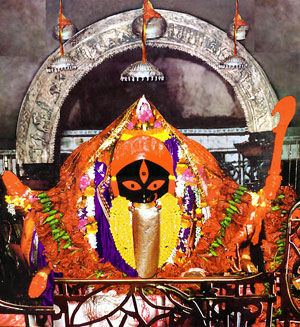Kalighat Temple
Kalighat is regarded as one of the 52 Shakti Peethams of India, where the various parts of Sati’s body are said to have fallen, in the course of Shiva’s Rudra Tandava. Kalighat represents the site where the toes of the right foot of Shakti or Sati fell. It is a very famous place and a pilgrimage for Shakta (Shiva and Durga/Kali/Shakti worshippers) followers within the Hindu religion.
The image of the deity is incomplete. Only the face of the deity was made first. The hands, made of gold and silver, the tongue, the Shiva statue and all the jewellery were added over the years. On snanyatra day, while giving the divine Mother the ceremonial bath, the priests tie their eyes with cloth coverings. On auspicious occasions like Kali Puja, Durga Puja, Poila Boishakh, the Bengali New Year day and sankranti large number of devotees throng the place with offerings.
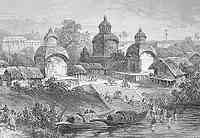
History
The Kalighat temple in its present form is only about 200 years old, although it has been referred to in Mansar Bhasan composed in the 15th century, and in Kavi Kankan Chandi of the 17th century.
Only two types of coins of Chandragupta II, who incorporated Vanga in the Gupta Empire, are known from Bengal. His Archer type coins, which became the most popular type of coinage with the Gupta rulers after Kumaragupta I, have been found in Kalighat. This is evidence of the antiquity of the place. The original temple was a small hut. A small temple was constructed by King Manasingha in the early Sixteenth century. The present temple was erected under the patronage of the Sabarna Roy Chowdhury family of Banisha. It was completed in 1809. The Haldar family claims to be the original owners of the temple property. But this was disputed by the Chowdhrys of Banisha. In the nineteen sixties a committee was formed for the administrative management of the temple with representation from the Government and the Haldar family.
It is necessary to know the history of the temple to understand the practices which are prevalent today. There is a complex organization involving Sevaiyats, Phaledars, Mishras, and Sathi Brahmins.
The Government of West Bengal has taken a lot of interest in improving the temple which is also one of the biggest tourist attractions. They have sanctioned funds for improving the temple. An office cum guest accommodation was constructed at a huge cost some years back. The building is now being run by the Tourism Development corporation as a guest house.
Accommodation is available for pilgrims here Some Devotees have approached the courts over the years for improving the temple. The courts have taken a keen interest in improving the temple. New construction is continuing inside the temple and a lot of improvements have been brought about.
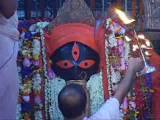
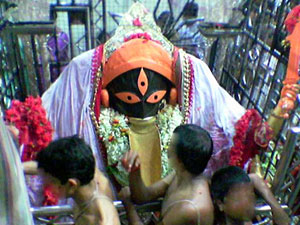
Visit
Kalighat is located in south Calcutta. Buses are available from all parts of Calcutta. All buses going to south Calcutta have to pass through Shyam Prasad Mukherjee road. The temple is off this road. You get down in Kalighat (Kalighat Tram Depot) bus stop and walk down the Kali Temple road to the temple. Kalighat is connected by Metro railway.
The nearest metro stations are Jatin Das Park and Kalighat . Please take the Northern exit in Jatin Das Park and the Southern exit in Kalighat. The steps in Jatin Das Park station are many and steep. There is an escalator part of the way in Kalighat station. It is advisable for elderly people to alight at the Kalighat station.
The temple is open from 5.00 A.M. to 2.00 P.M and 5.00 P.M to 10.30 P.M. It is closed from 2.00 P.M to 5.00 P.M. for Bhog. There are Aarthis in the morning and evening.
The temple schedule as per the notice put up.
Sun/Sat/Tue Weekdays
Opening Time
(For Mongal Aarti)
4.00 A.M
Opening Time
(For Public)
5.00 A.M
Nitya Puja
5.30 A.M to 7.00 A.M
5.30 A.M to 7.00 A.M
Bhog Rag
2.30 P.M. to 3.30 P.M.
2.00 P.M. to 3.00 P.M.
Sandhya Aarti
6.30 P.M. to 7.00 P.M.
6.30 P.M. to 7.00 P.M.
Closing of Temple
11.30 P.M.
10.30 P.M.
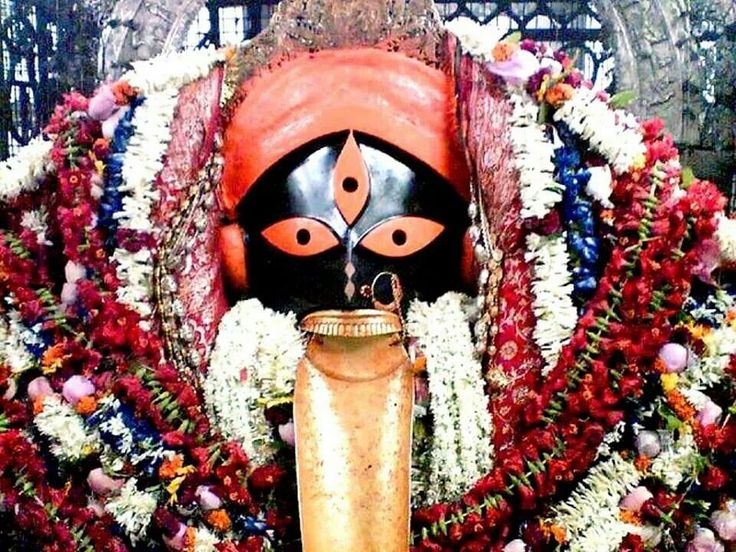
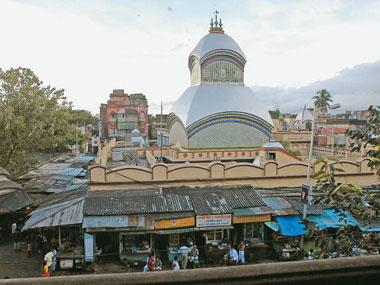
Legend
The legend of Sati is associated with the destruction of Daksha’s sacrifice and the origin of the Shakti Peethas of India. Sati, the wife of Shiva was the daughter of Daksha Prajaapati a descendant of Bhrama. She is known as Dakshayani. Sati married Shiva against the wishes of her father. The vain Daksha then performed a great yagna (with the sole aim of insulting Shiva), to which he invited all of the gods and goddesses except his son in law Shiva. Against Shiva’s wishes, Sati attended this sacrifice and was insulted by her father. Unable to bear this insult, Sati immolated herself on the Homa.
Enraged at the insult and the injury, Shiva through Veerabhadra, destroyed Daksha’s sacrifice, cut off Daksha’s head and replaced it with that of a goat, as he restored him to life. Still crazed with grief, he picked up the remains of Sati’s body, and danced the dance of destruction throughout the Universe. The other gods intervened to stop this dance, and the disk of Vishnu cut through the corpse of Sati, whose various parts of the body fell at several spots all through the Indian subcontinent and formed the sites of what are known as Shakti Peethas today.
Kalighat is regarded as one of the 52 Shakti Peetha of India, where the various parts of Sati’s body are said to have fallen, in the course of Shiva’s Rudra Tandava. Kalighat represents the site where the toes of the right foot of Shakti or Sati fell.
Legend has it that a devotee discovered a luminant ray of light coming from the Bhagirathi river bed, and upon investigating its source came upon a piece of stone carved in the form of a human toe. He also found a Svayambhu Lingam of Nakuleshwar Bhairav nearby, and started worshipping Kali in the midst of a thick jungle.
The temple is associated with the Nath/Siddha tradition. Chowringee Natha is said to have founded the Kali temple of Kalighat.
Chowringee Natha was a Nath Siddha and a disciple of Gorakshaknatha also known as Goraknatha. Legends say that Chowringee Natha was the son of King Devapala of Bengal. Devapala`s first wife died while Chowringee Natha was still a child, and his father married a woman who resorted to deception in order to place her own son on the throne. Chowringee Natha was taken to a forest clearing where his arms and legs were cut off. Here Chowringee Natha met Matsyendranatha who instructed Gorakhnatha to care for the limbless youth. Gorakhnatha taught him Yoga and after twelve years of this practice his limbs were unbelievably restored by the power of his own realization.
His name Chowringee Natha probably is derived from “Four Limbs (anga)”, and the shape of his torso as a bulb. This shape of his body possibly refers to his practice of Khanda Manda yoga. The main north-south thoroughfare across the city of Calcutta is now known after his name as Chowringee.
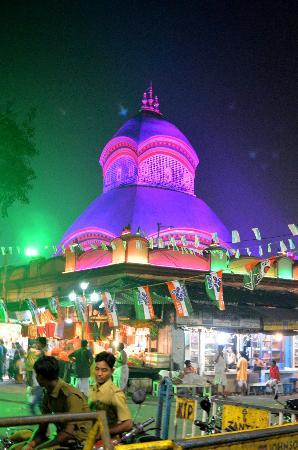
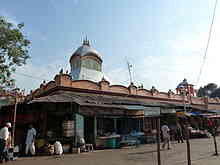

নাম : কালীঘাট মন্দির
অবস্থান : কালীঘাট , কলকাতা।
স্থাপত্য ও সংস্কৃতি
প্রধান দেবতা : কালী
স্থাপত্য শৈলী : মধ্যযুগীয় বঙ্গীয় স্থাপত্যশৈলী
কালীঘাট কালী মন্দিরের মা কালীর মূর্তি
কালীঘাট মন্দির কলকাতার একটি প্রসিদ্ধ
কালীমন্দির এবং একান্ন শক্তিপীঠের
অন্যতম হিন্দু তীর্থক্ষেত্র । এই তীর্থের
পীঠদেবী দক্ষিণাকালী এবং ভৈরব বা
পীঠরক্ষক দেবতা নকুলেশ্বর । পৌরাণিক
কিংবদন্তি অনুসারে, সতীর দেহত্যাগের পর
তাঁর ডান পায়ের চারটি (মতান্তরে একটি)
আঙুল এই তীর্থে পতিত হয়েছিল। কালীঘাট
একটি বহু প্রাচীন কালীক্ষেত্র। কোনো
কোনো গবেষক মনে করেন, “কালীক্ষেত্র”
বা “কালীঘাট” কথাটি “কলকাতা” নামটির
উদ্ভব। জনশ্রুতি, ব্রহ্মানন্দ গিরি ও
আত্মারাম ব্রহ্মচারী নামে দুই সন্ন্যাসী
কষ্টিপাথরের একটি শিলাখণ্ডে দেবীর
রূপদান করেন। ১৮০৯ সালে বড়িশার সাবর্ণ
জমিদার শিবদাস চৌধুরী, তাঁর পুত্র রামলাল
ও ভ্রাতুষ্পুত্র লক্ষ্মীকান্তের উদ্যোগে
আদিগঙ্গার তীরে বর্তমান মন্দিরটি
নির্মিত হয়েছে। পরবর্তীকালে মন্দিরের
কিছু পোড়ামাটির কাজ নষ্ট হয়ে গেলে
সন্তোষ রায়চৌধুরী সেগুলি সংস্কার করেন।
বর্তমান এই মন্দিরটি নব্বই ফুট উঁচু। এটি
নির্মান করতে আট বছর সময় লেগেছিল এবং
খরচ হয়েছিল ৩০,০০০ টাকা। মন্দির সংলগ্ন
জমিটির মোট আয়তন ১ বিঘে ১১ কাঠা ৩
ছটাক; বঙ্গীয় আটচালা স্থাপত্যশৈলীতে
নির্মিত মূল মন্দিরটির আয়তন অবশ্য মাত্র ৮
কাঠা। মূল মন্দির সংলগ্ন অনেকগুলি
ছোটো ছোটো মন্দিরে রাধাকৃষ্ণ , শিব
প্রভৃতি দেবতা পূজিত হন।
কালীঘাট কালীমন্দিরের কষ্টিপাথরের
কালীমূর্তিটি অভিনব রীতিতে নির্মিত।
মূর্তিটির জিভ, দাঁত ও মুকুট সোনার। হাত ও
মুণ্ডমালাটিও সোনার। মন্দিরে মধ্যে একটি
সিন্দুকে সতীর প্রস্তরীভূত অঙ্গটি রক্ষিত
আছে; এটি কারোর সম্মুখে বের করা হয় না।
প্রতি বছর পয়লা বৈশাখ , দুর্গাপূজা ও
দীপান্বিতা কালীপূজার দিন মন্দিরে প্রচুর
ভক্ত ও পু্ণ্যার্থীর সমাগম ঘটে।
কালীঘাট মন্দিরের নিকটেই পীঠরক্ষক
দেবতা নকুলেশ্বর শিবের মন্দির। ১৮৫৪ সালে
তারা সিং নামে জনৈক পাঞ্জাবি
ব্যবসায়ী বর্তমান নকুলেশ্বর মন্দিরটি
নির্মাণ করিয়েছিলেন। শিবরাত্রি ও
নীলষষ্ঠী উপলক্ষ্যে এই মন্দিরে প্রচুর ভক্ত
সমাগম হয়। কালীমন্দিরের পশ্চিম দিকে
রয়েছে শ্যাম রায়ের মন্দির। ১৮৪৩
খ্রিস্টাব্দে বাওয়ালির জমিদার
উদয়নারায়ণ মণ্ডল এই মন্দিরটি নির্মাণ
করিয়েছিলেন। এখানে রামনবমী ও
দোলযাত্রা অনুষ্ঠিত হয়। ১৮৬২ সালে
শবদাহের জন্য মন্দিরের অদূরে নির্মিত হয়
কেওড়াতলা মহাশ্মশান। বাংলার বহু
বিশিষ্ট ব্যক্তিত্বের শেষকৃত্য সম্পন্ন হয়েছে
এই শ্মশানে। এখানকার শ্মশানকালী পূজা
বিখ্যাত।
পৌরাণিক কিংবদন্তি
সতীপীঠ কালীঘাট
সত্যযুগে দক্ষ প্রজাপতি স্বগৃহে এক মহাযজ্ঞের
আয়োজন করেছিলেন। সেই যজ্ঞে দেবতা,
মুনি-ঋষি, যক্ষ, কিন্নর সকলকে নিমন্ত্রণ
করলেও, দক্ষ আপন কন্যা সতী ও জামাতা
শিবকে নিমন্ত্রণ জানাননি। সতী বিনা
আমন্ত্রণে যজ্ঞস্থলে উপস্থিত হলে, তাঁর
সম্মুখেই যক্ষ শিবের নিন্দা করেন।
পতিনিন্দা সহ্য করতে না পেরে তৎক্ষণাৎ
যজ্ঞকুণ্ডে আত্মবিসর্জন দেন সতী। তখন শিব
ক্রুদ্ধ হয়ে সতীর শবদেহ স্কন্ধে নিয়ে
বিশ্বধ্বংস করার উদ্দেশ্যে তাণ্ডবনৃত্য শুরু
করেন। তাঁকে শান্ত করতে বিশ্বপালক বিষ্ণু
আপন সুদর্শন চক্র দিয়ে সতীর দেহ খণ্ডবিখণ্ড
করে দেন। সতীর খণ্ডবিখণ্ড দেহের
টুকরোগুলি পৃথিবীর নানা স্থানে পতিত
হয়েছিল। পৃথিবীতে পড়ামাত্রই এগুলি
প্রস্তরখণ্ডে পরিণত হয়। পীঠমালা তন্ত্র
অনুযায়ী, সতীর ডান পায়ের চারটি আঙুল
পড়েছিল কালীঘাটে।



Make your visit to the temple a worthwhile and pleasant experience.
Please note the following carefully.
GENERAL
1. The temple is crowded on Tuesdays, Saturdays and Sundays. It is less crowded early in the morning before
8.A.M. If you can, plan your trip for a Wednesday early morning.
2. Avoid taking cell phones and digital cameras to the temple. If you do have to take them, keep them inside
your handbag while entering the temple.
3. Do not carry a heavy wallet/purse openly. Take out a particular amount of money and keep it separately where you can reach it easily. I have seen people pulling out their wallets inside the Garbagraha and the front varandah. This is risky and is tempting pick pockets.
Keep your wallet/purse inside your bag safely.
Carry enough change in the form of 10 rupee notes, 50 rupee notes and 100 rupee notes. People end up by
shelling out 100 rupees where 10 rupees would have been sufficient.
TOUTS/BROKERS/MIDDLE-MEN
Now when you enter the Kali Temple road, you will be approached by persons who will promise you a quick
Dharshan.
Now most of these people are touts/dalals/middle-men who have very little to do with the temple.
There two categories in these.
a. Operators who act on behalf of some of the sweet shops. You will know them when they want you to go to the shop first. Here you are asked to buy some Peda or other sweets to be offered as Prasad. Then they take
you to the temple.
Some of these shops do have a lot of influence in the temple and they may be able to arrange for a quick Dharshan. But it would cost you a lot of money. Of
course there is no guarantee.
You will find a number of local people who make use of these shops which are scattered around the temple. My
wife and family do. They provide a place to rest, keep your slippers.
But on busy days they may not be able to help.
You can approach these people if you are in a hurry and would not mind spending money to have a quick
Dharshan. But please enquire whether they can take you inside the Garbagraha. No Dharshan from the front varandah or the Nat Mandir.
b. Dalals who hand you over to another Panda for taking you inside the temple. There are some who might
take you to the temple. Most of these do not have any influence in the temple. They depend on muscle power.
They would take you to the Jor Bangla (the Varandah in the front), muscle their way through the crowd and ask
you to have a quick Dharshan. Some of them do not even do that. They take you to the Nat Mandir and ask
you to have Dharshan from there Please avoid these touts. Your experience will not bepleasant.
